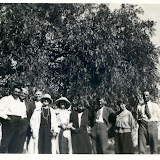"Why, I heerd a mother screamin’ when her kid went tossin’ by
Ridin’ bareback on a bucker that had murder in his eye."
Henry Lawson A Word to Texas Jack
When Kelly the Mug died sometime in the 1930s, the obituarists around Donnybrook in Western Australia’s south fondly recalled the ruses he’d pulled on them. One involved a horse he had entered in a local race. On the morning of the event he made sure he was seen galloping into town on the animal then claimed he’d ridden it all night just to make it in time. The bookmakers assumed it must have been exhausted and raised the odds. When it won and Kelly the Mug had pocketed his winnings, he took it back to its float hidden in the bush on the outskirts. That’s a trick you can only pull off once.
At country race meets around Australia horse owners still try an old favourite. In the morning their families sit around barbecues not far from the starting gate. Just before a race the jockey wanders over, ostensibly to receive a bit of encouragement. Someone pulls a potato from the billycan that has been boiling away and surreptitiously passes it to him. Mounting his horse, he raises a hand to give it a slap on the rump. In goes the potato and as the barriers go up the horse bolts away. It hurts, but it’s safer than drugs.
The 24 photographs here comprise a complete album of snapshots taken at a race meeting in the Australian bush. There are no inscriptions on them but elementary detective work - the cars, the clothes - indicates they were taken in the early 1930s, probably around Kalgoorlie on Western Australia’s goldfields. Technically they are amateurish, the shutter set at an unnecessarily slow speed for bright sun and overexposed, and the framing is loose. But photography doesn’t have to be good to be interesting.
Most snapshot albums are an assemblage of images placed without any sense of narrative. In this case we have a story with a traditional beginning, middle and end. (That there are 24 photos in the album suggests they might have come from the one roll.) The entire event probably began around 10 in the morning and finished around 4 in the afternoon. We have the spectators gathering, the jockeys leading their horses out, a race, a winner and a final race. Admittedly the story is more interesting for its historical rather than its dramatic content. Incidents that we might think significant probably escaped the photographer, or rather, he or she chose not to record them. This was supposed to be for fun, for reunions with people who maybe met up twice a year, not a sociological study.
Still, there are details for the sociologist in us all. It’s understandable that people dress up for an event but out here, on the edge of the desert, a suit and tie is taking things a bit far. John Berger wrote an essay, The Suit and the Photograph, describing how the outfit was a claim on respectability for three village musicians in an August Sander photograph. The people in these photos already have what Sander’s musicians wanted. They are station managers and horse owners at a time when Australia built its wealth on agriculture. They might not have been rich but they weren’t doing too badly. In those years Australia was still a very English country, coloured pink on the world map and saluting the King; even the accents broadcast across the wireless were very English. People took their cues on how to behave and what to wear from the British. In their way these people are country squires. They wear suits because they have that rural conservatism that requires formality, even when the temperature hangs about the high thirties. There’s no beer or food about either, even though a few evidently have a warm relationship with the liquid amber. They were sensible, abstemious types who knew that if they’d started drinking in the sun the whole day could quickly fall apart. Afterwards of course they’d drive into town or to the station manager’s house and open a few bottles. For now it’s the races that matter, and around the world the racetrack, like the church or the opera house, has always required a high standard of dress. Even at a small event like this, in an isolated outpost, one has to follow venerable tradition.
In cinema the closing shot can be more important than the opening scene. Someone walks away and the camera pulls back to reveal a deserted street or the protagonist looks across a landscape that has had its equilibrium restored. The final image in this series, of the cars lined up with the windmill and the water tank in the background, catches a moment before the credits roll. As the photographer departs the scene retreats and in a minute the cars will be specks on the horizon. There’s another thing to be said about it. When the photographer took this shot they wanted to remember the day in its entirety. The photograph is already nostalgic for something that has passed. This was the place where all the action took place and the cars are the people who took part in it.
VIEW THE GALLERY HERE
 |
| A DAY AT THE RACES |




No comments:
Post a Comment
Add comments here